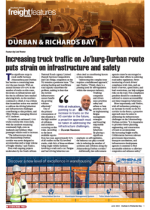Richards Bay Bulk Terminal has been diligently working to overcome its challenges and improve its operational efficiency. Following two fire incidents in October 2021, which affected nine conveyor routes out of 86, the terminal had taken significant steps towards recovery and continuity, said Reggie Mthembu, Transnet Port Terminals (TPT) acting managing executive for Richards Bay Te r m i n a l s .The Port of Richards Bay was dumped into crisis mode after the two incidents. “Following that incident, the terminal introduced alternative cargo handling methods for impacted commodities and currently runs a hybrid operation of both skips and conveyors to ensure continuity,” said Mthembu.A contractor appointed last month is currently in the process of removing the damaged material from the conveyor routes. The work is expected to be completed by the end of July, and the rebuilt conveyor belt is anticipated to resume operations before the end of the year.To address truck congestion, a persistent challenge arising from increased global demand for certain bulk commodities, Richards Bay Bulk Terminal has implemented several initiatives. A letter was issued to all mining companies stating that unbooked trucks would no longer be handled f rom mid-May.“The terminal has implemented a truck booking system to allocate slots per truck to alleviate congestion effectively. Additionally, efforts are under way to repair the road infrastructure and restore the stormwater drainage system, with the appointment of a contractor for the task,” said Mthembu.In terms of performance, he said the terminal had exceeded the 24 million tons handled in the previous financial year as of the end of March this year. “Coal exports have been a significant contributor to this improved performance. The company is undergoing audit processes to ascertain the precise numbers and is expected to release them soon. The terminal foresees demand remaining consistent, with handling volumes similar to the previous financial year, 2022/2023. However, potential risks include f luctuations in commodity prices linked to energy disparities and global GDP.”

